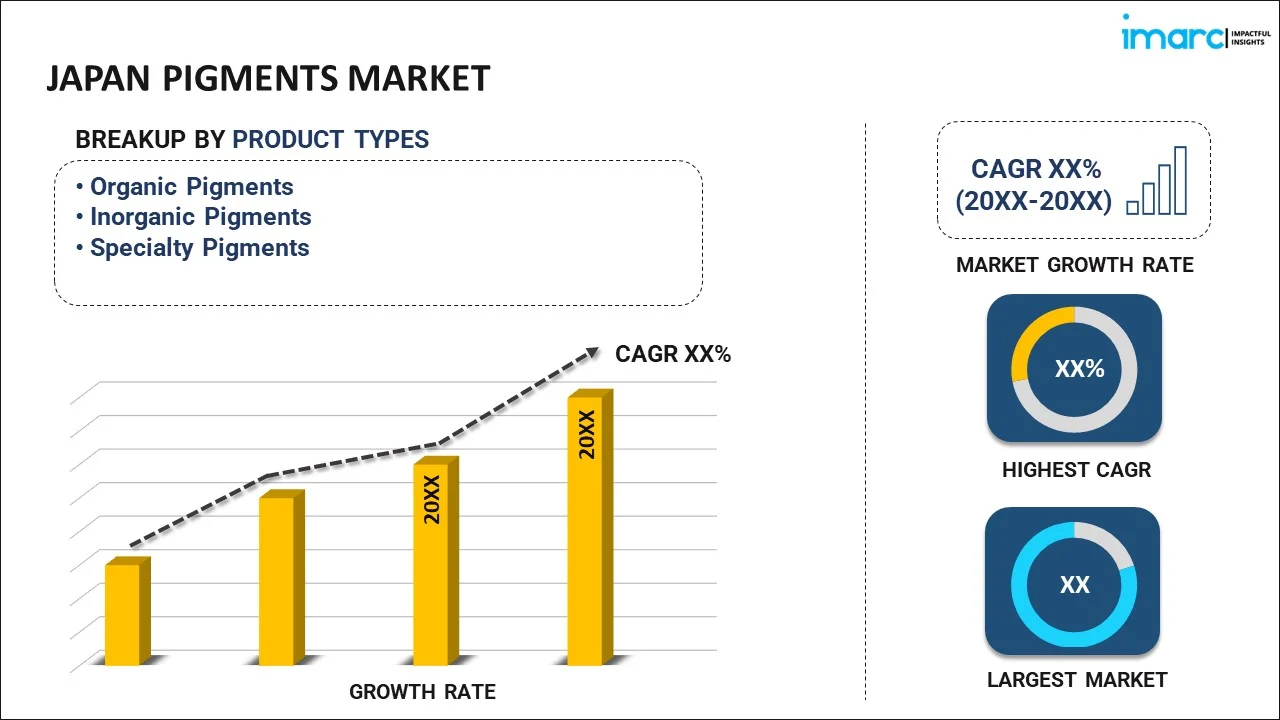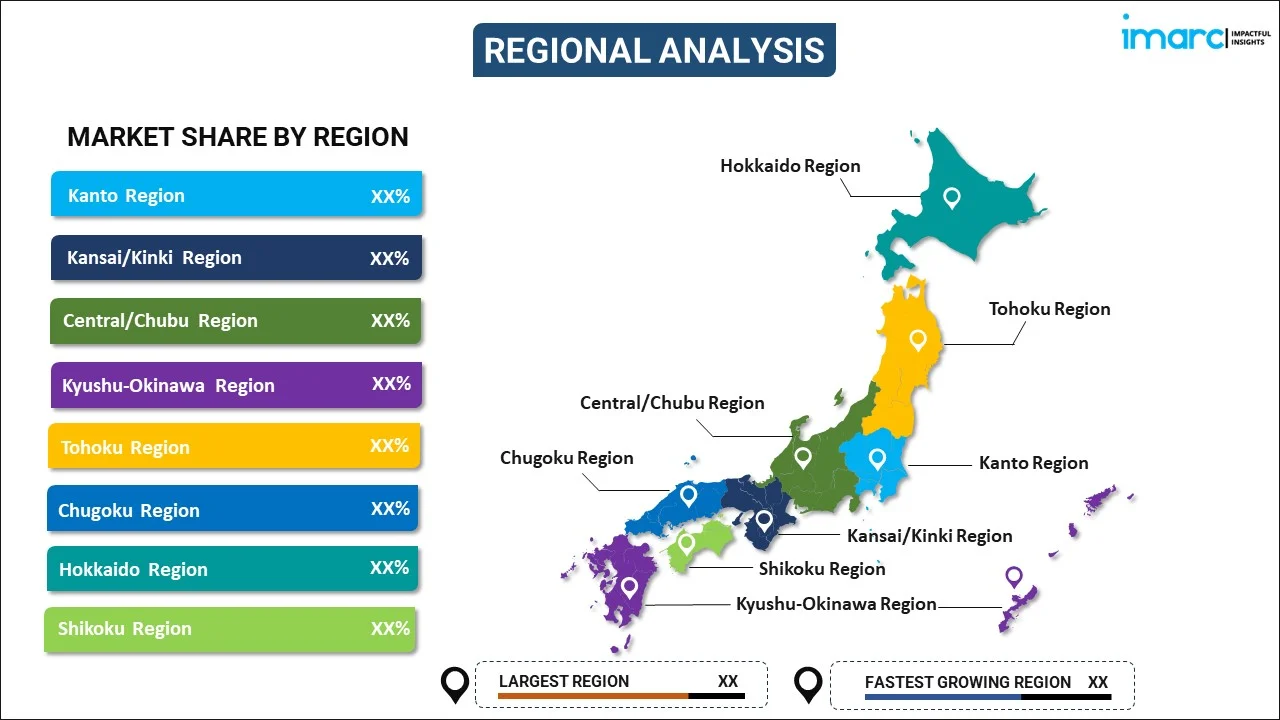
Japan Pigments Market Report by Product Type (Organic Pigments, Inorganic Pigments, Specialty Pigments), Color Index (Red, Orange, Yellow, Blue, Green, Brown, and Others), Application (Paints and Coatings, Plastics, Printing Inks, Construction Materials, and Others), and Region 2025-2033
Market Overview:
Japan pigments market size reached USD 1.3 Billion in 2024. Looking forward, IMARC Group expects the market to reach USD 2.2 Billion by 2033, exhibiting a growth rate (CAGR) of 5.3% during 2025-2033. The increasing prevalence of various end-use industries such as automotive, construction, packaging, and textiles, coupled with the rising demand for pigments used in their products, is driving the market.
|
Report Attribute
|
Key Statistics
|
|---|---|
|
Base Year
|
2024
|
|
Forecast Years
|
2025-2033
|
|
Historical Years
|
2019-2024
|
|
Market Size in 2024
|
USD 1.3 Billion |
|
Market Forecast in 2033
|
USD 2.2 Billion |
| Market Growth Rate 2025-2033 | 5.3% |
Pigments are colored substances that are widely used in various industries and applications. They play a crucial role in providing color and visual appeal to a wide range of products, including paints, inks, plastics, cosmetics, textiles, and more. Pigments can be either organic or inorganic compounds, and their color is determined by their chemical composition and structure. In the realm of art and design, pigments have been integral to the creation of vibrant and expressive works for centuries. Artists have relied on pigments to mix and create an extensive palette of colors for their paintings and other artistic creations. The quality and durability of pigments have a significant impact on the longevity and visual impact of these artworks. In industrial applications, pigments are used to provide coloration and functional properties to products. In the cosmetics industry, pigments are essential for creating makeup products with various shades. Overall, pigments are versatile substances that contribute to the world of color and design while also serving functional purposes in numerous products across various sectors.
Japan Pigments Market Trends:
The regional market for pigments has witnessed considerable growth, primarily driven by several interconnected factors. Firstly, there has been a robust increase in demand from the paint and coatings industry, which is directly linked to the upsurge in infrastructural development and urbanization. In addition to this, the automobile sector, renowned for its extensive use of pigments in car paints, plays a pivotal role in boosting the market. Moreover, the burgeoning cosmetics industry, with its relentless need for a diverse range of colors and shades, further fuels the demand for high-quality pigments. Furthermore, the growing awareness about the harmful effects of synthetic colors in food products has driven the demand for natural and organic pigments in the food and beverage sector. To illustrate, the surge in popularity of clean-label and organic products prompts manufacturers to opt for natural colorants, thereby propelling the market forward. Besides this, several technological advancements, which have led to the innovation of eco-friendly and sustainable pigments to appeal to a broader spectrum of environmentally conscious consumers and manufacturers, are expected to drive the regional pigments market in the coming years.
Japan Pigments Market Segmentation:
IMARC Group provides an analysis of the key trends in each segment of the market, along with forecasts at the country level for 2025-2033. Our report has categorized the market based on product type, color index, and application.
Product Type Insights:

- Organic Pigments
- Azo Pigments
- Phthalocyanine Pigment
- Quinacridone Pigment
- Others
- Inorganic Pigments
- Titanium Dioxide Pigments
- Iron Oxide Pigments
- Cadmium Pigments
- Carbon Black Pigments
- Chromium Oxide Pigments
- Complex Inorganic Pigments
- Others
- Specialty Pigments
- Classic Organic Pigments
- Metallic Pigments
- High-Performance Pigments
- Light Interference Pigments
- Fluorescent Pigment
- Luminescent Pigments
- Thermo-Chromic Pigments
The report has provided a detailed breakup and analysis of the market based on the product type. This includes organic pigments (azo pigments, phthalocyanine pigment, quinacridone pigment, and others), inorganic pigments (titanium dioxide pigments, iron oxide pigments, cadmium pigments, carbon black pigments, chromium oxide pigments, complex inorganic pigments, and others), and specialty pigments (classic organic pigments, metallic pigments, high-performance pigments, light interference pigments, fluorescent pigment, luminescent pigments, and thermo-chromic pigments).
Color Index Insights:
- Red
- Orange
- Yellow
- Blue
- Green
- Brown
- Others
A detailed breakup and analysis of the market based on the color index have also been provided in the report. This includes red, orange, yellow, blue, green, brown, and others.
Application Insights:
- Paints and Coatings
- Plastics
- Printing Inks
- Construction Materials
- Others
The report has provided a detailed breakup and analysis of the market based on the application. This includes paints and coatings, plastics, printing inks, construction materials, and others.
Regional Insights:

- Kanto Region
- Kansai/Kinki Region
- Central/ Chubu Region
- Kyushu-Okinawa Region
- Tohoku Region
- Chugoku Region
- Hokkaido Region
- Shikoku Region
The report has also provided a comprehensive analysis of all the major regional markets, which include Kanto Region, Kansai/Kinki Region, Central/ Chubu Region, Kyushu-Okinawa Region, Tohoku Region, Chugoku Region, Hokkaido Region, and Shikoku Region.
Competitive Landscape:
The market research report has also provided a comprehensive analysis of the competitive landscape. Competitive analysis such as market structure, key player positioning, top winning strategies, competitive dashboard, and company evaluation quadrant has been covered in the report. Also, detailed profiles of all major companies have been provided. Some of the key players include:
- Dainichiseika Color & Chemicals Mfg. Co. Ltd.
- DIC Corporation
- Fuji Pigment Co. Ltd.
- Ishihara Techno Corporation
- Nagase & Co. Ltd.
- Nemoto & Co. Ltd.
- Sanyo Color Works LTD.
(Please note that this is only a partial list of the key players, and the complete list is provided in the report.)
Japan Pigments Market Report Coverage:
| Report Features | Details |
|---|---|
| Base Year of the Analysis | 2024 |
| Historical Period | 2019-2024 |
| Forecast Period | 2025-2033 |
| Units | Billion USD |
| Scope of the Report | Exploration of Historical Trends and Market Outlook, Industry Catalysts and Challenges, Segment-Wise Historical and Future Market Assessment:
|
| Product Types Covered |
|
| Colors Index Covered | Red, Orange, Yellow, Blue, Green, Brown, Others |
| Applications Covered | Paints and Coatings, Plastics, Printing Inks, Construction Materials, Others |
| Regions Covered | Kanto Region, Kansai/Kinki Region, Central/ Chubu Region, Kyushu-Okinawa Region, Tohoku Region, Chugoku Region, Hokkaido Region, Shikoku Region |
| Companies Covered | Dainichiseika Color & Chemicals Mfg. Co. Ltd., DIC Corporation, Fuji Pigment Co. Ltd., Ishihara Techno Corporation, Nagase & Co. Ltd., Nemoto & Co. Ltd., Sanyo Color Works LTD., etc. |
| Customization Scope | 10% Free Customization |
| Post-Sale Analyst Support | 10-12 Weeks |
| Delivery Format | PDF and Excel through Email (We can also provide the editable version of the report in PPT/Word format on special request) |
Key Questions Answered in This Report:
- How has the Japan pigments market performed so far and how will it perform in the coming years?
- What has been the impact of COVID-19 on the Japan pigments market?
- What is the breakup of the Japan pigments market on the basis of product type?
- What is the breakup of the Japan pigments market on the basis of color index?
- What is the breakup of the Japan pigments market on the basis of application?
- What are the various stages in the value chain of the Japan pigments market?
- What are the key driving factors and challenges in the Japan pigments?
- What is the structure of the Japan pigments market and who are the key players?
- What is the degree of competition in the Japan pigments market?
Key Benefits for Stakeholders:
- IMARC’s industry report offers a comprehensive quantitative analysis of various market segments, historical and current market trends, market forecasts, and dynamics of the Japan pigments market from 2019-2033.
- The research report provides the latest information on the market drivers, challenges, and opportunities in the Japan pigments market.
- Porter's five forces analysis assist stakeholders in assessing the impact of new entrants, competitive rivalry, supplier power, buyer power, and the threat of substitution. It helps stakeholders to analyze the level of competition within the Japan pigments industry and its attractiveness.
- Competitive landscape allows stakeholders to understand their competitive environment and provides an insight into the current positions of key players in the market.
Need more help?
- Speak to our experienced analysts for insights on the current market scenarios.
- Include additional segments and countries to customize the report as per your requirement.
- Gain an unparalleled competitive advantage in your domain by understanding how to utilize the report and positively impacting your operations and revenue.
- For further assistance, please connect with our analysts.
 Inquire Before Buying
Inquire Before Buying
 Speak to an Analyst
Speak to an Analyst
 Request Brochure
Request Brochure
 Request Customization
Request Customization




.webp)




.webp)












